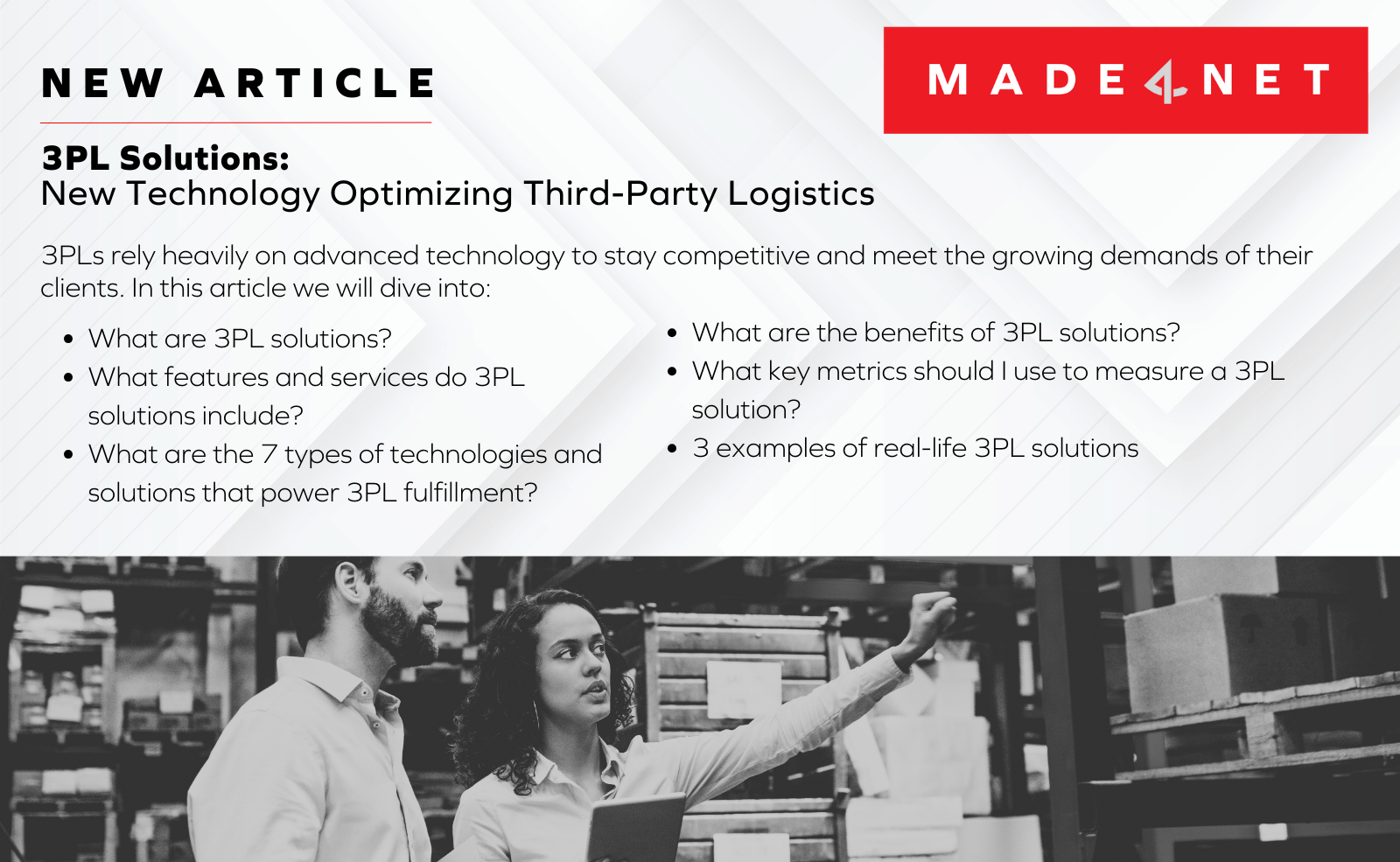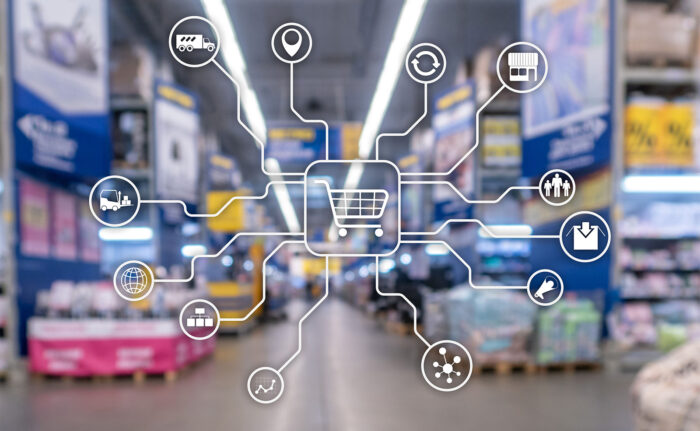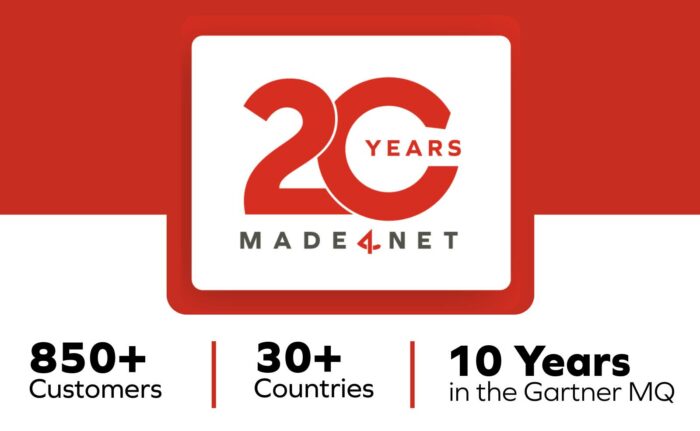
In today’s fast-paced logistics environment, third-party logistics providers (3PLs) rely heavily on advanced technology to stay competitive and meet the growing demands of their clients. From robust and reliable 3PL warehouse management systems and transportation management systems (TMS) to automation, real-time tracking, and data analytics, these technologies are the backbone of efficient operations.
In this post, we’ll take a deep dive into:
- What are 3PL solutions?
- What features and services do 3PL solutions include?
- What are the 7 types of technologies and solutions that power 3PL fulfillment?
- What are the benefits of 3PL solutions?
- What key metrics should I use to measure a 3PL solution?
- 3 examples of real-life 3PL solutions
What are 3PL Solutions?
A 3PL (Third-Party Logistics) solution refers to the outsourcing of logistics and supply chain management functions to an external provider. A 3PL company typically offers a range of services including warehousing, transportation, inventory management, order fulfillment, packaging, and distribution. These solutions are designed to help businesses improve efficiency, reduce costs, and enhance customer service by leveraging the 3PL’s expertise, infrastructure, and technology.
By partnering with a 3PL, businesses can focus on their core operations while the 3PL handles the complexities of supply chain logistics. 3PLs often use advanced technologies like Warehouse Management Systems (WMS), Transportation Management Systems (TMS), and automation to optimize processes, improve visibility, and ensure timely delivery of goods.
What Features and Services do 3PL Solutions Include?
3PL providers offer a variety of solutions designed to optimize supply chain efficiency. Here’s a closer look at the key features and services they provide:
Core Logistics
- Warehousing and inventory management: From storage solutions and real-time inventory tracking to slotting optimization, cross-docking, kitting, and returns processing, these services keep logistics running smoothly.
- Fulfillment and distribution: From order picking and packing, custom packaging, and labeling to e-commerce fulfillment and retail compliance, these solutions empower operations to reach distribution goals in one fell swoop.
- Transportation and freight management: By handling freight brokering, leading multimodal and intermodal transportation, driving last-mile delivery, and managing time-sensitive shipping and reverse logistics, 3PLs streamline the entire transportation process.
Technology
- Warehouse Management Systems (WMS): By handling the broad functions of a warehouse or distribution center, a WMS provides operations with inventory tracking using RFID, barcode scanning, and AI-powered insights. Along with automated workflows, labor management, and productivity tracking, a WMS ensures the entire operation is running smoothly.
- Transportation Management Systems (TMS): Dynamic route planning, load consolidations, carrier selection, and rate negotiations all come together in this one system to make distribution a breeze.
- IoT (Internet of Things): By using smart sensors, IoT provides real-time tracking of inventory, equipment, and shipments to monitor conditions like temperature, humidity, and location, improving visibility and reducing losses.
- Blockchain: With a transparent, tamper-proof ledger for tracking shipments, blockchain secures and streamlines supply chain transactions, verifying authenticity, and ensuring compliance, reducing disputes and fraud.
Value-added Services
- Industry-specific logistics: 3PLs offer specialized services tailored to cold chain logistics, hazardous material handling, and heavy equipment transport while ensuring compliance with industry regulations in sectors like pharmaceuticals, food, and beverage.
- Compliance services: Whether it’s customs clearance, duty management, or regulatory compliance, 3PLs simplify international trade and ensure smooth cross-border operations.
- Specialty offerings: For those requiring white-glove delivery, disaster recovery logistics, subscription service personalization, or dedicated sustainability initiatives, 3PLs provide tailored solutions to meet unique demands.
What are the 7 Types of Technologies and Solutions That Power 3PL Fulfillment?
In the dynamic world of 3PL, a suite of advanced technologies collaborates to streamline fulfillment processes, enhance efficiency, and elevate customer satisfaction. Key technologies and solutions powering 3PL fulfillment include:
- Warehouse Management Systems (WMS): WMS software oversees daily warehouse operations, such as inventory management, order processing, and shipping. It ensures optimal stock levels, productivity optimization, accurate order fulfillment, and efficient utilization of warehouse space.
- Transportation Management Systems (TMS): TMS facilitates the planning, execution, and optimization of the movement of goods outside of the four walls of the warehouse. It aids in route planning, carrier selection, freight auditing, and real-time tracking, contributing to cost reductions and improved delivery performance.
- Automation: Automated systems, including conveyors, sorters, and robotics, handle repetitive tasks such as sorting, packaging, and palletizing. This automation enhances operational speed, reduces human error, and lowers labor costs. For instance, Amazon utilizes over 750,000 robots in its fulfillment centers to streamline operations and expedite deliveries.
- Real-Time Tracking: Advanced tracking technologies, such as RFID, GPS, and IoT sensors, provide real-time visibility into the location and status of shipments. This transparency allows for proactive management of potential delays and enhances customer trust. Recent innovations have enabled packages to emit signals for continuous tracking, improving accuracy and reducing the risk of lost parcels.
- Data Analytics: Data analytics tools process vast amounts of operational data to derive insights into performance metrics, customer preferences, and market trends. These insights inform decision-making, optimize routes, forecast demand, and enhance overall supply chain efficiency.
- Voice-Directed Warehousing: Voice-directed systems utilize speech recognition to guide warehouse workers through tasks such as picking, receiving, and replenishment. By providing hands-free, eyes-free instructions, these systems improve accuracy, speed, and safety in warehouse operations.
- Artificial Intelligence (AI) and Robotics: AI-driven robotics enhance various aspects of fulfillment, from sorting packages to managing inventory. For example, FedEx’s investment in AI robotics company Nimble aims to bolster its supply chain capabilities, offering automated solutions for order fulfillment and inventory management.
Integrating these technologies enables 3PL providers to offer efficient, reliable, and scalable fulfillment services, meeting the evolving demands of modern commerce.
What are the Top 10 Benefits of 3PL Solutions?
Outsourcing logistics to a 3PL provider offers businesses a range of strategic advantages, from cost savings to enhanced efficiency and scalability.
3PL Solutions Benefit #1: Increased Efficiency
Working with a 3PL provider gives operations access to advanced technologies, customized solutions, and bulk shipping discounts. This helps to streamline processes, improve accuracy, and reduce delivery times. Working with a 3PL allows operations to focus on their core competencies while the 3PL handles logistics. As a result, businesses achieve increased productivity and growing profit margins.
3PL Solutions Benefit #2: Cost Savings
Managing logistics in-house is not only a daunting task, but a costly one too. It requires a hefty upfront investment in warehousing, transportation, technology, and personnel. Operations that outsource logistics to a 3PL can reduce overhead costs by benefiting from economies of scale, and by eliminating the need to pay for warehouse leases, labor, and fleet management.
3PL Solutions Benefit #3: Optimized Transportation
3PLs have established relationships with carriers, granting them access to a wide range of transportation networks, including less-than-truckload (LTL), full-truckload (FTL), air freight, and ocean shipping. These connections enable them to negotiate competitive shipping rates and optimize delivery routes, ensuring cost-effective and timely deliveries. By leveraging these networks, businesses gain access to affordable shipping solutions, real-time route tracking, and performance analytics that help minimize delays and enhance overall logistics performance.
3PL Solutions Benefit #4: Risk Management
3PL providers help mitigate challenges like customs regulations, carrier compliance, and shipping documentation, by ensuring adherence to trade regulations, and minimizing the risk of delays, fines, or customs holds. With in-depth knowledge of industry standards and legal requirements, they help businesses stay compliant and adapt to evolving trade policies.
3PL Solutions Benefit #5: Enhanced Customer Experience
Fast and reliable shipping is non-negotiable and essential for customer retention. 3PLs optimize last-mile delivery, enhance order accuracy, and reduce transit times, all of which improve the customer experience. Many also offer real-time tracking and automated notifications, increasing transparency and building customer confidence. By partnering with a 3PL, businesses can streamline fulfillment, expedite shipping, and avoid negative reviews caused by delays.
3PL Solutions Benefit #6: Scalability
Seasonal demand fluctuations are one of the biggest challenges operations face. Working with a 3PL allows businesses to expand and contract as needed without any change to their infrastructure. The flexibility afforded by working with a 3PL ensures businesses can adapt quickly without taking on the financial burden of maintaining fixed assets.
3PL Solutions Benefit #7: Access to Technology
Beyond industry expertise in handling necessary regulations, 3PLs have extensive experience with sophisticated technology offerings, like WMSs, TMSs, and AI-driven analytics to improve and strengthen supply chain performance. Businesses partnering with a 3PL have access to these tools and their benefits without the capital investment or required training.
3PL Solutions Benefit #8: Geographic Reach
Expanding into new regions comes with significant costs and logistical challenges. Partnering with a 3PL gives businesses access to strategically located warehouses and distribution centers, cutting shipping times and costs for customers across various locations. This approach enables market expansion without the expense of building new facilities. With a vast global logistics network, 3PLs simplify international shipping by assisting with customs procedures, tariffs, and cross-border compliance.
3PL Solutions Benefit #9: Improved Inventory Management
The wide array of technology used by 3PLs means businesses gain access to robust inventory management systems that provide real-time visibility into stock levels, helping optimize demand forecasting and automated replenishment. This is how businesses can minimize stockouts and reduce excess inventory, decreasing waste and improving order accuracy, leading to a more cost-effective supply chain.
3PL Solutions Benefit #10: Reverse Logistics
Returns processing is a complicated endeavor, but not for a 3PL. They simplify the process by managing returns efficiently, whether through restocking, refurbishment, or disposal. This not only reduces losses but also enhances customer satisfaction. With a well-structured returns system, businesses can process refunds and exchanges more quickly, boosting customer trust and operational efficiency. By effectively managing returned or defective products, 3PLs help protect profit margins and optimize inventory control.
What Key Metrics Should I Use to Measure a 3PL Solution?
Every business will have a different set of key performance indicators (KPIs) to track, ensuring a 3PL partnership aligns with operational goals and business objectives. Some KPIs, however, come standard to almost every operation’s requirements. When working with a 3PL, you’ll want to track:
Operational Efficiency
- Order Accuracy Rate
- On-Time Delivery RateDock-to-Stock Time
- Inventory Accuracy
- Cycle Time
Cost Management
- Cost Per Order
- Freight Cost per Unit
- Warehouse Utilization Rate
- Return Processing Cost
Customer Satisfaction
- Customer Order Cycle Time
- Perfect Order Rate
- Customer Retention Rate
- Complaint Resolution Time
Scalability
- Peak Season Performance
- Capacity Utilization
- Order Volume Growth Rate
Technology Performance
- Real-Time Tracking Accuracy
- EDI/API Uptime
- Automation Utilization
Tracking these KPIs will provide insight into whether the partnership is working well. It will also help to compare your 3PL’s performance against industry benchmarks to assess competitiveness and identify potential areas for improvement. With regular performance reviews, you can proactively foster an environment of continuous improvement, ensuring your operation is functioning at its best.
3 Examples of Real-life 3PL Solutions
In 2022, Zethcon and Made4net teamed up to deliver a cutting-edge warehouse management solution to the 3PL industry. Here’s a look at how three customers are benefiting from Synapse 3PLExpert.
3PL Solutions Example #1: Foster Logistics
Foster Logistics implemented Made4net’s 3PL WMS, Synapse, to streamline operations, enhance efficiency, and improve inventory control.
“Synapse has been very useful in all aspects of our warehouse. It helps us with inventory control, it helps us to go out and find a specific product. If we have a customer that tells us to look for a product with a specific lot number, Synapse makes it easy to identify.”
— Robin Mell, Customer Service Supervisor at Foster Logistics
3PL Solutions Example #2: Law Logistics
Law Logistics needed a WMS that could accommodate the unique requirements of its 50 diverse clients. Some customers rely on lot codes, while others need pallet-in/pallet-out workflows. Synapse offered the flexibility they required.
“When a customer asks for something, we can do it quickly—that’s one of the things that helps sell our business. Our flexibility and speed are thanks to Synapse.”
— Brian Wojick, Vice President of Warehouse Operations at Law Logistics
“The major benefit is a significant increase in accuracy. We came from paper picking and manual key punching. Immediately after implementing Synapse, we were able to get some significant efficiencies just being able to identify everything, not lose our inventory, and track our productivity.”
— Jeff Malone, Vice President of Information Technology at Law Logistics
3PL Solutions Example #3: RS Distribution
RS Distribution outgrew its legacy system of nearly 30 years when it implemented Synapse WMS. Since most of their products are food-grade, they needed a system that could handle log tracking and expiration date management.
“Everybody at Made4net is very responsive and has been able to address our problems. Synapse has helped us attract customers because we’re able to accommodate their specific needs, giving them transparency and reporting capabilities.”
— René Saurette, President of RS Distribution
Is a 3PL Solution Right For Me?
3PL solutions can significantly enhance your business operations by leveraging external expertise in logistics and supply chain management. These solutions typically encompass services like warehousing, transportation, inventory management, order fulfillment, packaging, and distribution. By partnering with a 3PL provider, you can benefit from cost savings, improved efficiency, scalability, and enhanced customer satisfaction. However, it’s important to consider potential challenges, such as the loss of direct control over logistics operations and ensuring seamless integration between your systems and those of the 3PL provider. Careful evaluation of your business needs and a thorough assessment of potential 3PL partners are essential to maximize the advantages of outsourcing logistics functions. Need more information on working with a 3PL solution? Our experts are here to help.


